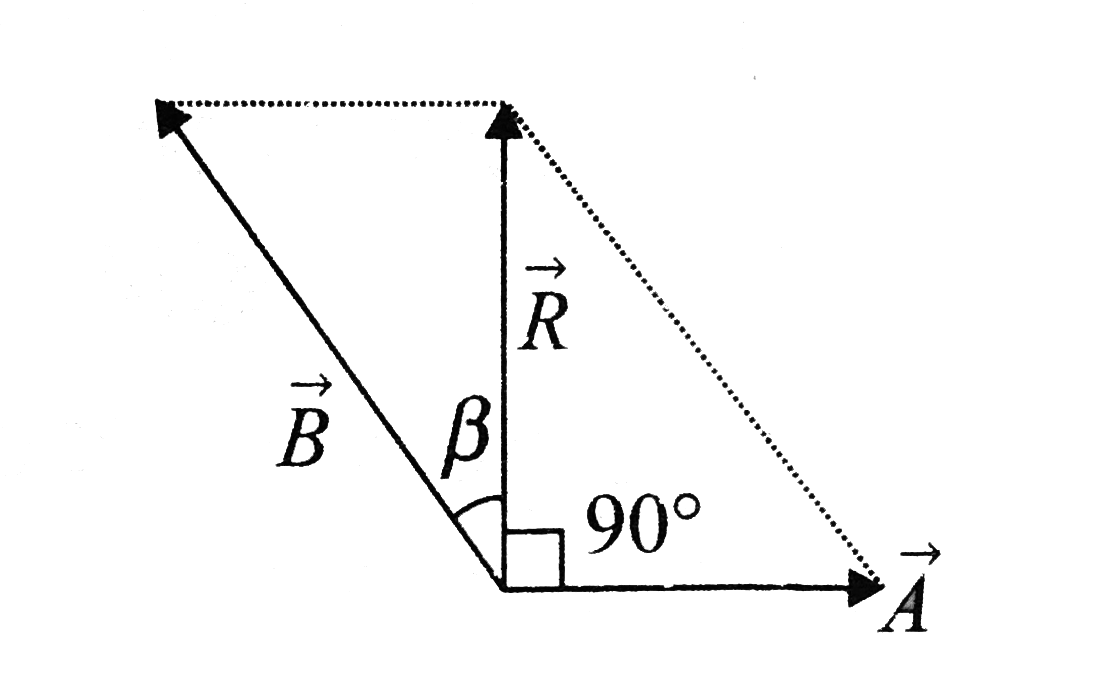The resultant of two vectors →A and →B is perpendicular to →A and equal to half of the magnitude of →B. Find the angle between →A and →B ?
Since →R is perpendicular to →A. figure shows the three vectors →A,→B and →R angle between →A and →B is p-q
sinq=RB=B2B=12
⇒q=30∘⇒ angle between A and B is 150∘.

Topper's Solved these Questions
- MOTION IN A PLANE Book:AAKASH SERIESChapter:MOTION IN A PLANE Exercise:Exercise -I
Explore 91 Videos
- MOTION IN A PLANE Book:AAKASH SERIESChapter:MOTION IN A PLANE Exercise:Exercise -II
Explore 135 Videos
- MECHANICAL PROPERTIES OF SOLIDSBook:AAKASH SERIESChapter:MECHANICAL PROPERTIES OF SOLIDSExercise:EXERCISE - 3
Explore 26 Videos
- MOTION IN A STRAIGHT LINEBook:AAKASH SERIESChapter:MOTION IN A STRAIGHT LINEExercise:Questions for Descriptive Answers
Explore 7 Videos
Similar Questions
The resultant of two velocity vectors →A and →B is perpendicular to →A. Magnitude of Resultant →R is equal to half magnitude of →B. If the angle between →A and →B is (30θ)∘, then value of θ is ?
View SolutionThe resultant of two vectors →A and →B is perpendicular to the vector →A and its magnitudes is equal to half of the magnitudes of vector →B (figure). The angle between →A and →B is

View Solution
Knowledge Check
The resultant of two vectors →Aand→B is perpendicular to the vector →A and its magnitude is equal to half the magnitude of vector →B. What is the angle between →Aand→B ?
A30∘B45∘C150∘D120∘The resultant of two vectors →A and →B is perpendicular to the vector →A and its magnitudes is equal to half of the magnitudes of vector →B (figure). The angle between →A and →B is
 A120∘B150∘C135∘DNone of these
A120∘B150∘C135∘DNone of theseThe resultant of →Aand→B is perpendicular to →A. What is angle between →Aand→B ?
Acos−1(AB)Bcos−1(−AB)Csin−1(AB)Dsin−1(−AB)
The resultant of two vectors →Aand→B perpendicular to the vector →Aanditsmagnitudequal→halfofthemagnitudeofthe→−−→r vec B.F∈doutthe∠between vec A and vec B.
View SolutionTwo vectors →Aand→B have equal magnitudes.If magnitude of (→A+→B) is equal to n times of the magnitude of (→A−→B) then the angle between →Aand→B is :-
View SolutionTwo vectors →A and →B have equal magnitudes . If magnitude of →A+→B is equal to n× the magnitude of →A−→B , then the angle between →A and →B is
View SolutionTwo vector →Vand→V have equal magnitudes. If magnitude of →A+→B is equal to n time the magnitude of →A−→B, then angel to between →Aand→B is
View SolutionGiven that →A+→B=→C and that →C is perpendicular to →A Further if ∣∣→A∣∣=∣∣→C∣∣, then what is the angle between →A and →B
View Solution

